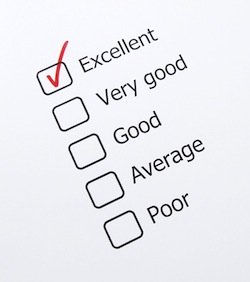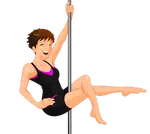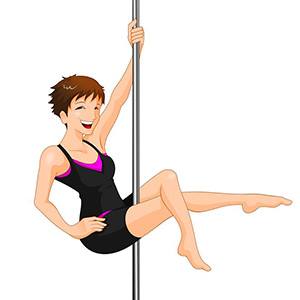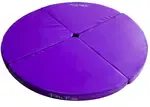- Home
- FAQ
- Pole Dance Instructor
- Become a Better Pole Dance Teacher
Tips To Become A Better Pole Dance Teacher
Becoming a better teacher is something all pole dance instructors can and should work towards. In fact, improving your teaching skills is just as important as staying up on the latest pole dancing tricks and moves.
Unfortunately, sometimes we pole instructors - unlike a teacher who gives lectures on abstract subjects like philosophy - can get so wrapped up in our subject matter and in the skill set of "doing pole," that we sometimes forget about the teaching end of things.
That's why it can be helpful to take a step back every now and then, and see if there are things we could do differently to become a better pole dance teacher.
Here are 3 tips to help you do just that, plus one bonus tip to tie it all together. Ready? Here we go!
Tip #1: Invite Feedback
Feedback rarely happens on its own, so if you want some you'll usually have to go out and get it. Often we ask our students for feedback, for example with a written evaluation at the end of a class session.

However, it's often the case that students aren't willing to give really honest feedback.
If they like your class they'll keep coming, and they'll usually be willing to give you a great evaluation or leave a positive review or testimonial But if they don't, they tend to just quietly disappear without telling you why they didn't come back.
And while it's great to hear the positive comments, keep in mind that just because you aren't getting feedback from students who might have something "negative" to say, doesn't mean there isn't room for improvement.
Honest feedback is really what you're after if you truly want to continue improving as a pole dance teacher. While online collection methods like surveys, email, and reviews are convenient, most people realize they can't be anonymous. For this reason, comments received via these methods may be less likely to provide the truly honest feedback you want. To avoid this issue, think about going low-tech.
You could place a comment box in the change room for example, with a supply of pencils and either blank comment forms or short surveys. Putting the comment box in a more private area of your studio can encourage students who have criticisms or suggestions (vs rave reviews) to share these, as they won't feel that front desk or teaching staff are going to see who is putting comments in the box.
An alternative way of gathering feedback that can be very beneficial, is to ask colleagues for some specific suggestions on how you can improve. After all, you're all pole dance teaching professionals and you understand the role of honest critique in improving your skills.
One advantage is that this kind of feedback is much easier to get. Just invite a fellow instructor or two to assist in your class, and ask them to give you some feedback after the class is over. You can reciprocate for them another time so you'll both benefit.
Another option is to arrange to get together with
other teachers at your studio once a month or even once a quarter, and
take turns teaching each other. Then provide each other with feedback, including what was done well, and what areas could be improved.
Tip #2: Attend Classes With Other Pole Dance Teachers
The fact is, it's easy to get stale and not even realize it, if the only
pole dance class you ever go to is your own! Attending classes with other pole dance teachers gives you an opportunity to relax a little and enjoy being a student, instead of having the pressure and responsibility of teaching. And just as importantly, it gives you a chance to experience another instructor's style as well as the opportunity to pick up some specific teaching techniques that you might want to incorporate into your own repertoire.
There's no doubt about it, it can definitely take some effort to actually go to someone else's class. After all, you're busy with your own teaching, and chances are you work during the times when many other classes are offered.
But if you plan ahead and make it a goal
to attend another instructor's class even twice a year, you're
guaranteed to get a new perspective on the art of teaching pole dance. You might
even pick
up a new tip or idea that will blend well with your own teaching
techniques or style.
Tip #3: Take A Break!
Believe it or not, taking regular breaks from your teaching duties can have a hugely positive effect on your overall effectiveness as an instructor.
Wait a minute...how can taking time away from the studio help you to become a better pole dance teacher?
The fact is, teaching is very energy-intensive. You're "on" all the time, and it's often difficult to hit the off switch, especially after you've been teaching for a number of years.
The good news is, you don't need to take an extensive holiday. Even taking a one week break between class sessions can be beneficial, and a longer break once or twice a year is invaluable if you can swing it. You'll come back to class feeling refreshed and recharged after having some time away from the pressures and responsibilities of being a pole dance teacher.
If you're a studio owner as well as an instructor, Your Pole Pal knows that it can be extra hard to take time off. Not only do you have your teaching schedule to work with, you also have a business to run. In this case, taking time off might feel like a luxury you just can't afford.
But with some creative thinking and planning, you may be able to find a way. For example, the week between Christmas and New Year's, as well as late Summer, are often especially slow periods in the fitness industry. Can you plan to take a few days (or even a whole week!) away from your studio at one of these times? You may find that your absence has little, if any, impact on business, and that the benefits are well worth it.
One Final Tip
No matter how good you think you are; no matter how much your students say they love your classes; and no matter how many testimonials you have on your bulletin board or on your website, never, ever assume you're so good that you can't become an even better pole dance teacher!
Remember: what's great today may be only "good enough" tomorrow. In order to stay on the leading edge of both the art of pole dancing and the art of teaching, it's important to continually strive to be the best you can be.
Oh, and just one more thing: have fun! It might sound trite, but if your students see that you genuinely enjoy not only pole dancing, but also teaching, your enthusiasm and delight will go a long way to helping them feel comfortable so they can really enjoy your class.
What's New?
-
Find Colorado Pole Dancing Classes
Oct 31, 25 02:44 PM
Searching for Colorado pole dancing opportunities? Come on in and let us help you find a class near you with our free directory. -
Plus Size Dance Pole Guide - Top Poles with Higher Weight Limits
Jul 31, 25 03:03 PM
What's the best plus size dance pole? Not all poles are created equal. Find out which brands support higher weight limits, and which ones to avoid. -
Pole Dance Studios in Brazil | Global Pole Directory
Jul 26, 25 04:55 PM
Explore pole dance studios and instructors across Brazil. Find pole fitness classes for all levels and styles with the Brazil pole dancing directory. -
Pole Fitness in Hawaii | Worldwide Pole Dance Directory
Jul 14, 25 11:39 PM
Searching for pole fitness in Hawaii? Look no further! Discover pole studios and instructors across Hawaii and start your pole dance fitness adventure today! . -
London Pole Studios & More | Pole Dancing in England
Jul 13, 25 11:44 PM
Discover top pole studios in London as well as pole dancing classes throughout England. Find local studios near you to start your pole dancing adventure today.
Your Pole Pal loves to have fun, but she also has to earn a living, right? That's why you'll see ads on this site. She may also earn commissions on some of the products you'll see here, but there's never any cost to you since the advertisers pay for these.
The income generated through these means helps ensure Your Pole Pal can devote the time to providing you with all the free and fabulous information & resources you'll find on this website.
Want to learn more? Your Pole Pal invites to you read her full advertising disclosure. You know...in case you haven't read enough legalese lately.




